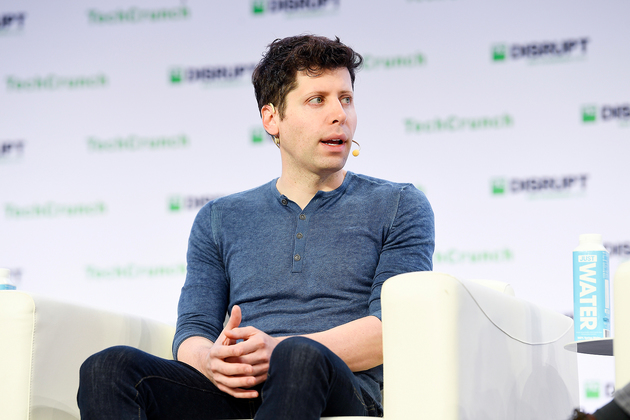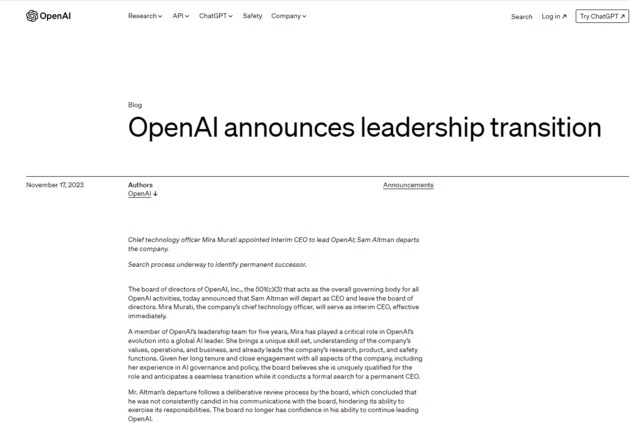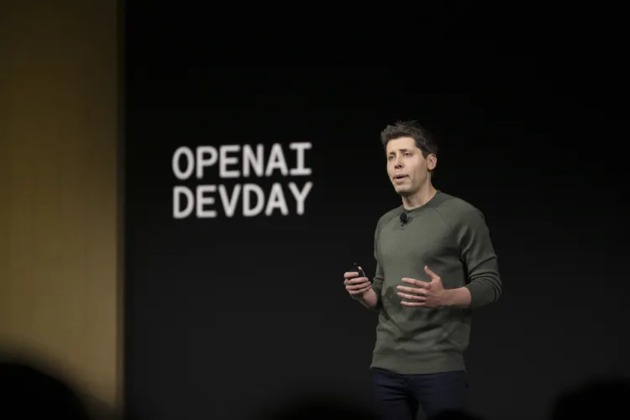
Photo/VCG
Overnight, the management team of OpenAI, the global leader in generative artificial intelligence technology, suddenly changed.
On Friday (November 17), the OpenAI board announced that Sam Altman stepped down as CEO with immediate effect, due to losing confidence in his ability to lead the company. On the same day, Greg Brockman also announced his resignation as chairman of the OpenAI board but will continue to work at the company and report to the CEO. The company’s chief technology officer, Mira Murati, will serve as interim CEO, and is also looking for a permanent successor. OpenAI’s four-person core team seems to be falling apart.

Photo/OpenAI
However, according to foreign media analysis, the conflict between Altman and the OpenAI board of directors may have already existed for a long time, and the outbreak was only a matter of time.
OpenAI’s four-person core team seems falling apart
Last November, OpenAI's ChatGPT3.5 chatbot program was released to the world, sparking global enthusiasm for artificial intelligence research and application. The four-person core team behind this blockbuster product was also exposed.
However, with OpenAI's statement, the four-person core team also showed signs of division. Brockman, Altman's close friend, also immediately announced his resignation as chairman of OpenAI's board of directors after the statement.

From right to left are Ilya Sutskever, chief scientist; Greg Brockman, president and chairman; Sam Altman, and Mira Murati, chief technology officer. Image source: Screenshot of The New York Times.
In 2015, Altman hosted a private dinner, where he talked about his dream of creating a socially beneficial AI company. Among the Silicon Valley celebrities present were Musk and Brockman, who was then the chief technology officer of the digital payment company Stripe.
Brockman, who was inspired by Altman’s speech, joined the creation of OpenAI. The two had similar experiences and hit it off. Brockman grew up on a farm in North Dakota and entered Harvard in 2008. He intended to pursue a double degree in mathematics and computer science but soon found himself more interested in the real world. He dropped out of Harvard after a year, then transferred to MIT, but dropped out again after a few months. This time he moved to San Francisco and plunged into the world of startups. He was one of the founding members of Stripe, which had grown from a two-person project to a $20 billion company when he left.
Unlike the previous two, the chief scientist of the four-person team, Sutskever, was a bona fide academic prodigy. He was born in the Soviet Union before the end of the Cold War, studied in Israel for two years, and moved to Canada in 2002, where he obtained his PhD under the guidance of Geoffrey Hinton, the “father of deep learning”. After graduating, he became a scientist at Google Brain, where he co-created the Seq2Seq learning algorithm. In 2015, he left Google and joined OpenAI, becoming the company’s most relied-on scientist, with an annual salary of $1.9 million at the start. In 2022, Sutskever was elected as a fellow of the Royal Society of Britain.
The only woman among the four was the chief technology officer, Mira Murati. She was responsible for the development of ChatGPT and the AI drawing tool DALL-E, and was named by Time magazine as the creator of ChatGPT. She is the main contributor to the productization of OpenAI’s research results. This may be due to her three years of work experience at Tesla, where she was the senior product manager of Model X.
Murati was born in Albania and moved to Canada at the age of 16. She then obtained an engineering degree from Dartmouth College in the United States. Murati has always emphasized the possibility of AI being abused in public interviews, and called for stronger regulation. She believes that AI technology should be transparent, and users should be able to understand and control the behavior and decision-making process of AI systems. User safety and privacy protection are also equally important.
According to OpenAI’s latest statement, Murati will serve as interim CEO, and the company is also looking for a permanent successor.
Speculations about Altman's leave
There are many speculations about the reason for Altman’s departure. But what exactly happened between Altman and OpenAI, leading to the board’s sudden dismissal of him without any warning? The US tech media TechCrunch sorted out some purely speculative theories.
The first possibility is that Altman and Brockman, who resigned on Friday, wanted to make some bolder attempts, but the OpenAI board did not like them. The two often discussed specific plans in private, and then presented them as established facts to the board, which was not uncommon. However, if the plan was controversial enough, the OpenAI board would not give in, making it the fuse for Altman’s dismissal.
As OpenAI’s largest investor, few people would be shocked if Microsoft got involved in OpenAI’s operations. However, if Altman collaborated with Microsoft and other OpenAI investors in private, this might cause the board’s dissatisfaction. In addition, if Altman wanted to manage OpenAI independently, this might also trigger the board’s fiduciary duty or other legal obligations.
Second, according to foreign media, Microsoft had suspended the use of ChatGPT internally a few days ago, which may reflect that OpenAI is experiencing a major and possibly widespread security issue. With the launch of custom GPT tools (GPTs), the explosive user usage made OpenAI suspend the registration of new users for ChatGPT Plus. In addition, there is also the possibility of large-scale abuse, as a large amount of personal data is transmitted through OpenAI’s API and services. If OpenAI’s main product had serious security issues, but Altman showed a dismissive attitude, this would obviously cause the board’s distrust.
In addition to security issues, Altman’s dismissive attitude towards the fact that OpenAI’s database contained a large amount of pirated content might also have caused the board’s displeasure.
Third, Altman often discussed the possibility of general artificial intelligence (AGI) with passion in public. This is a theoretical software system that can achieve human-like intelligence and versatility. However, the OpenAI board clearly stated in its statement, “OpenAI is to advance our mission: to ensure that artificial intelligence benefits all of humanity”. Altman initially led OpenAI towards a more corporate direction, changed the company’s legal status, and actively pursued applications for businesses and consumers, which did not sound like the “mission” that the board wanted to advance. Therefore, Altman’s passion for general artificial intelligence might also be one of the reasons that caused a major disagreement between him and the board.
May cause shock to global tech industry
The sudden departure of Altman has caused a shock in the global tech industry and politics, where he has already become a central figure in the debate on artificial intelligence regulation, according to The Washington Post. Altman is a rare figure in Silicon Valley’s history: in less than a year, he went from being the founder of a failed startup to becoming a global sensation in the entire San Francisco Bay Area and beyond, and then one of the world’s most influential business leaders.
After the news of Altman’s departure broke, tech investors and practitioners across San Francisco expressed shock and wondered why the OpenAI board decided to fire him. According to The Washington Post, more than a dozen executives and investors in the artificial intelligence industry expressed confusion and surprise when talking to the newspaper’s reporters.
Altman has always been the spokesperson for OpenAI. Last year, OpenAI launched the stunning generative artificial intelligence ChatGPT, which quickly sparked a global “arms race” in artificial intelligence. Just last week, Altman gave a keynote speech at the first DevDay conference hosted by OpenAI, where OpenAI announced a series of major updates to compete with large tech companies such as Microsoft and Google. On Thursday, Altman also gave a speech at the Asia-Pacific Economic Cooperation (APEC) meeting as the CEO of OpenAI.

Altman at OPENAI DEVDAY
Photo/OpenAI
According to foreign media reports, Altman not only wants to make OpenAI the leader in generative artificial intelligence, but also discussed with Apple’s chief designer Jony Ive to create an “iPhone of artificial intelligence”. However, he downplayed these rumors in a recent interview with the Wall Street Journal. In addition, Altman is also the largest shareholder of Humane, a company that just launched the Humane AI Pin order.
As a co-founder of OpenAI, Altman initially served as the company’s co-chair with Musk. However, Musk left OpenAI in 2018 to avoid conflicts of interest with Tesla. According to the US technology media The Verge, unlike the traditional private company board, OpenAI’s board is mainly composed of external people. After Altman and Brockman left, the remaining board members include the company’s chief scientist Ilya Sutskever, independent director Quora CEO Adam D’Angelo, technology entrepreneur Tasha McCauley and Georgetown Center for Security and Emerging Technology strategic director Helen Toner.
Despite the company’s huge development, the board’s basic governance responsibility is still to advance OpenAI’s mission and maintain the principles of its charter.
Although Altman is one of the founders of OpenAI, he said he does not hold any shares in the company. During his tenure as OpenAI CEO, Altman continued to invest in other companies, such as nuclear fusion company Helion and artificial intelligence hardware startup Humane, and now he is the latter’s largest shareholder. According to data from the venture capital data company PitchBook, Altman has made dozens of investments in startups over the years, of which 12 were made this year alone.
After Altman’s resignation news came out, Microsoft said it will continue to cooperate with OpenAI. A Microsoft spokesperson said in a statement, “We have a long-term partnership with OpenAI, and Microsoft will continue to work with Murali and his team to bring the next era of artificial intelligence to our customers.” In addition, Microsoft CEO Nadella also made a similar statement on X.


 川公网安备 51019002001991号
川公网安备 51019002001991号





